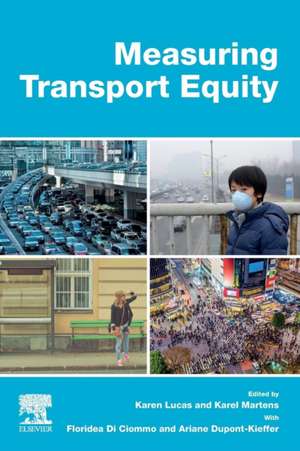Measuring Transport Equity
Editat de Karen Lucas, Karel Martens, Floridea Di Ciommo, Ariane Dupont-Kiefferen Limba Engleză Paperback – 30 mai 2019
- Written by a collection of top researchers and upcoming scholars in the transport field
- Shows how to apply transport equity measurement ideas in the real world through case study examples
- Covers emerging transport topics, including the use of advanced measures of inequality
- Includes learning aids, such as methodology, application, policy relevance, and further reading
Preț: 572.62 lei
Preț vechi: 785.32 lei
-27% Nou
Puncte Express: 859
Preț estimativ în valută:
109.59€ • 113.97$ • 91.71£
109.59€ • 113.97$ • 91.71£
Carte tipărită la comandă
Livrare economică 07-21 martie
Preluare comenzi: 021 569.72.76
Specificații
ISBN-13: 9780128148181
ISBN-10: 0128148187
Pagini: 328
Dimensiuni: 152 x 229 x 16 mm
Greutate: 0.44 kg
Editura: ELSEVIER SCIENCE
ISBN-10: 0128148187
Pagini: 328
Dimensiuni: 152 x 229 x 16 mm
Greutate: 0.44 kg
Editura: ELSEVIER SCIENCE
Public țintă
Transportation planning academic researchers, graduate students, practitioners, and policy makersCuprins
Part One: Introduction
1. Introduction
2. Measuring transport equity: Key components, framings and metrics
Part Two: Benefits of transport: Accessibility
3. An index to measure accessibility poverty risk
4. Using person-based accessibility measures to assess the equity of transport systems
5. Equity analysis of dynamic bike-and-ride accessibility in the Netherlands
6. Can the urban poor reach their jobs? Evaluating equity effects of relocation and public transport projects in Ahmedabad, India
7. Transport equity in low-income societies: Affordability impact on destination accessibility measures
Part Three: Burdens of transport: Health, environment and other externalities
8. The health impacts of urban transport: Linkages, tools and research needs
9. Assessing health inequalities related to urban and transport determinants of mental health
10. A public health approach to assessing road safety equity – the RoSE cycle
11. Distribution of transportation "goods" and "bads" in a Canadian metropolis: a diagnosis of the situation and potential interventions to tackle environmental disparities
12. Safety and daily mobilities of urban women: - Methodologies to confront the policy of "invisibility"
Part Four: Social outcomes from transport interventions
13. Applying a subjective wellbeing lens to transport equity
14. Social impact assessment: The case of bus rapid transit in the city of Quito, Ecuador
15. Measuring the influence of social capital and personal networks on transport disadvantage
16. Using a capability approach-based survey for reducing equity gaps in transport appraisal. Application in Santiago de Chile
17. A behavioral framework for needs-based transport assessment
18. Assessing the equity impacts of a transportation investment program
Part Five: Closure
19. Conclusion
1. Introduction
2. Measuring transport equity: Key components, framings and metrics
Part Two: Benefits of transport: Accessibility
3. An index to measure accessibility poverty risk
4. Using person-based accessibility measures to assess the equity of transport systems
5. Equity analysis of dynamic bike-and-ride accessibility in the Netherlands
6. Can the urban poor reach their jobs? Evaluating equity effects of relocation and public transport projects in Ahmedabad, India
7. Transport equity in low-income societies: Affordability impact on destination accessibility measures
Part Three: Burdens of transport: Health, environment and other externalities
8. The health impacts of urban transport: Linkages, tools and research needs
9. Assessing health inequalities related to urban and transport determinants of mental health
10. A public health approach to assessing road safety equity – the RoSE cycle
11. Distribution of transportation "goods" and "bads" in a Canadian metropolis: a diagnosis of the situation and potential interventions to tackle environmental disparities
12. Safety and daily mobilities of urban women: - Methodologies to confront the policy of "invisibility"
Part Four: Social outcomes from transport interventions
13. Applying a subjective wellbeing lens to transport equity
14. Social impact assessment: The case of bus rapid transit in the city of Quito, Ecuador
15. Measuring the influence of social capital and personal networks on transport disadvantage
16. Using a capability approach-based survey for reducing equity gaps in transport appraisal. Application in Santiago de Chile
17. A behavioral framework for needs-based transport assessment
18. Assessing the equity impacts of a transportation investment program
Part Five: Closure
19. Conclusion
